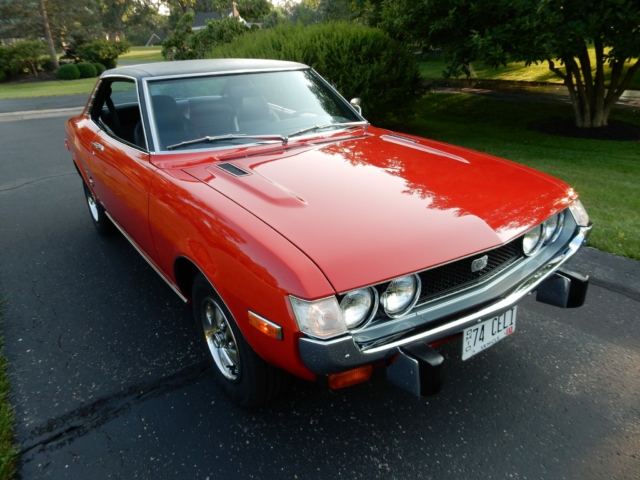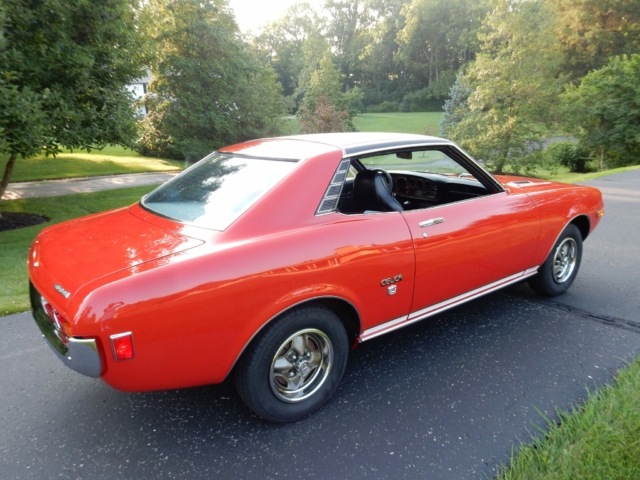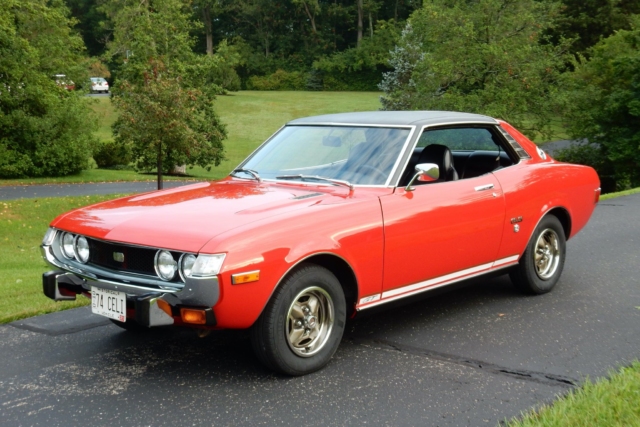We don’t need to tell you that the acceptance of Japanese cars as collectible classics is pushing prices to previously unseen heights. Among some makes and models, values of so-so condition cars are shooting past what cream puffs once traded for, which only ratchets the prices of the truly well-preserved examples even higher. The latest example is a Cincinnati, Ohio 1974 Toyota Celica that just sold for $61,000.
Now, what we’re about to say is going to sound like we’re hating on the car, but we assure you that’s not the case. It’s a beautiful example. It’s just that, though this auction on Bring a Trailer was a top dollar sale, it’s not truly a top dollar car. By 1974, carmakers were on their way to the dreaded 5-mph safety bumpers. That meant most Japanese cars eventually had to ditch their slim, body contoured chrome for ugly steel beams. Toyota in 1974 was transitioning to that inevitability from the intended design of the car, adding small bumperettes to the “smiley” bumpers. They’re not as egregious as the safety girders, but hardcore Celica collectors still prize most the pre-bumperette 1971-73 examples.
Now, the seller describes how in 2016 the bumpers were re-chromed and at that time the rear bumperettes removed and the holes in the main bumper filled — which leads us to another issue. Several aspects of the car are not original. There’s the bumperettes, the fact that the antenna was removed and the hole in the fender filled, and door speakers added by cutting out some of the door cards. The car has been repainted in its original 335 Red with some evidence of overspray.
The seller wasn’t trying to hide any of this. In fact, they were more than honest in the description by disclosing it all. Plus, it’s only natural that the seller would want some better sounding tunes as the decades progressed. It’s unlikely that even the original owner, which this seller is, thought that the car would ever ascend to a value six times higher than a same-year Jaguar XJ6.
The main selling point of the Celica seems to be that it’s a one-owner car. And that owner has truly done an admirable job of curating the car over its 74,000-mile life. It even won its class at the 2017 Cincinnati Concours d’Elegance. We’re just as surprised as anyone that a mid-year Celica that’s close but not quite bone stock and that doesn’t have museum-spec mileage has sold for $61,000.
Earlier this year a 1976 Celica Liftback sold for $62,000, but there were some unique circumstances to that sale. That doesn’t seem to be the case with this one. So, to put it another way, if this 1974 Celica went that high, what would a 1971-73 Celica in showroom-mint condition go for (of course, there the challenge would be finding one)? Or better yet, what about a Japan-spec TA22 with the 2T-G twin-cam engine? The days of six-figure Celicas are probably not too far off in the future.
Images: Bring a Trailer















The truly amazing thing about the car is the drivers seat hasn’t ripped. That vented vinyl never lasted very long.
My first new car was a ’77 Celica coupe, 5 spd, same color red.
I was watching this on BAT and my jaw opened when it went past 30 and was on the floor when it passed 40. I am now looking for it in my basement.
LOL
Although Toyota produced tens of thousands of Celicas between 1971 and 1974, there are so few left that are complete, and even fewer in this condition. About one or two pop up every week on Facebook, usually resembling a movie prop from a post-war apocalypse: half rusted, 4 different colors, panels and parts stripped, or in a pile next to the chassis. And even those can fetch a few grand from desperate buyers with big dreams.
You want a ’76 or ’77? No problem- those are readily available in comparison. A concours ’72-’75? Well, this was your chance. Hopefully the fantastic result will bring a few more out of the woodwork.
Oh, and a concours ’71? Foggedaboutit! I think I’ve seen one for sale in the past 3-4 years. U
What’s the replacement parts situation with these Celicas? I’ve been told it’s hard to find anything for them, which is probably why derelict ones stay that way.
There are few Toyota spares available for any model of this age, other than what can be harvested from other cars. Some small manufacturers sell inexpensive Celica rubber repops and miscellaneous pieces, with highly variable degrees of quality. Buying a parts-compete car (like this example) is the best alternative. IMHO This is partly why the ’71 Celica which sold earlier on BaT only went for $15K – it would need many thousands of dollars in parts alone, before a restoration would be finished.
I’d say that the FJ40 crowd has done a better job than rest of the Toyota crowd in terms of congregating parts suppliers.
Considering what plain ’70s domestic iron in much less original condition is selling for these days, this is not surprising. All it requires is an overinflated market for cars, and one determined buyer.
I understand the nostalgia factor and the dearth of available supply, but what do buyers see in spending this kind of money on what was referred to back then as a “secretary’s car”? This model wasn’t by any means revolutionary (like the original Z), had pedestrian performance, and lacked racing pedigree (unlike the 510). And as noted, it’s post-73, which means it chokes on emissions equipment. Having long ago driven a friend’s smogged and bumpered ’75 Celica, I can assure you that driving one isn’t exactly a thrilling experience. In fact, it felt downright agrarian.
Another advantage of buying a classic car is that unless you got caught up in a bidding war, your new purchase will at least hold its value and then some. That has been the case with my ’67 Alfa Romeo Spyder, which was not only technologically sophisticated for its time, but a blast to drive, and has increased in value five-fold during the 18 years I’ve owned it. Will this ’74 Celica be worth $61k in the future? For that amount, I would invest in a mint ’70 Z, ’79 RX7 or that showroom-new CRX from a few weeks ago. They will continue appreciating, and you’ll have fun driving them too, which is really the whole point of buying a classic.
That’s the point. What makes a car a “classic” to someone is the desire for it.
A pristine ’76 Plymouth Volare is worth the money to somebody who wants it.
We are now at the point where people who grew up with these cars desire them again, just as they did when they were on the showroom floors back in ’74.
Guess what…Someday a 2011 Hyundai will be a “collector car” to somebody.
We’re talking about two different things. I’m speaking to the value proposition of cars like this ’74 Celica at $61k. How sustainable is that in the long term when there are cars with much higher upside when it’s time to sell it? Hence, the editor’s point that even among first generation Celicas, a smogged and bumpered post’-73 version is not the holy grail, and my argument that there are plenty of better cars out there as an investment at that lofty price.
Also, by definition, something doesn’t become a “classic” just because you have a handful of die-hard fans supporting the cause. The dictionary defines the word “classic” as 1. Belonging to the highest rank or class; 2. Serving as the established model or standard; 3. Having lasting significance or worth; enduring. None of your examples come even close to the mark.
So if you want to buy that Pinto/Vega/Chevette/B210/F10 that you grew up with because they were desirable to you back then, and remain so today, then no one is stopping you from spending a mint buying one in showroom condition, or restoring them. Just don’t expect the marketplace to reward you for your efforts.
Frankly, this feels a touch preachy. IMHO we should both not confuse market timing with market prowess. You and I have both been fortunate that some of the pedestrian cars we have owned for 10 or 20 years have had a nice uptick in value, but the simple truth is that in 30 years, no one is likely to want most cars from the 60s and 70s, and that unfortunately includes your Duetto, as well as this Celica.
It’s an observation of where the current market is for older cars, and also a criticism of flippers like the reseller of this particular Celica. Like many collector hobbies, the vehicle market has drawn quick rich dilettantes, and they are in usual fashion ruining it for those of us who want to enjoy learning about, owning, wrenching, and driving them. How many of you can afford to spend $61k on a ’74 Celica? When I bought my Duetto, it was to enjoy the act of restoring and driving them, and not as an investment. The same when I bought a new S2000 to share garage space with the Alfa. That they have maintained and gained market value is merely a side benefit. Will future generations appreciate these cars in 30 years when I am no longer around? I know my children will, having learned about the place in automotive history regarding these “pedestrian” models. Hopefully, yours will too.
It’s as sustainable as long as somebody else wants it and has the deep pockets.
You my friend don’t understand “classic car” is labeled as such by motor vehicle. 25 years old + depending on the state you are in.
“Collector Car” is a name assigned to a vehicle that has demand in the market place.
Collector cars are a moving target. As one generation ages out, demand goes away. As the new generation comes into their own with money in their pockets they (the market), now determines what are the new collectable cars/trucks.
In not too many years nobody will be interested in ’55 Chevy’s like they were 30 years ago.
The Celica was an affordable coupe that also happened to be well built and reliable. It was the first new car for many young professionals and the high school/college car for many others. Nostalgia has nothing to do with performance numbers or whether one car was better than another, its all about what the car meant to you when you owned it. In that area the Celica shines. I have owned many performance cars that were much more fun to drive, but none of them got me through college and my first job like my 76 Celica GT did.
Nostalgia is indeed what drives the booms and busts in the collector market. Some cars survive the cycle better than others, usually because they stood out in its era for having superior performance, design and quality. My new ’85 Dodge Colt with no A/C and hand-cranked windows got me through grad school, and although it was very reliable, I have no yearning to go back to that. On the other hand, I can see myself spending serious money on a mint CRX Si which I wanted to buy, but with a growing family, had to “compromise” with a new ’90 Civic Si. Those Hondas set a benchmark for subcompacts back then (and I would argue even now), which is why their collective values have skyrocketed.
The mongrel Celica sells for $61K with 40 bids from 11 bidders.
A vastly superior, technologically sophisticated 1968 Alfa Spider sold on BAT for 29K with 23 bids from 7 bidders. Seems to me, the mongrel Toyota has more of a following than the pedigree Alfa.
Back in the day, I had a chance to experience my friends
technologically sophisticated Alfa Spider but unfortunately we couldn’t get it started.
****************Flagged for not being constructive***********
I’m probably late to the party here- but USDM ’73 Celicas have the 5 MPH Bumper overriders as well. Only ’71-’72s have the cleaner bumpers.
I assume they didn’t remove the bumperettes from the front bumper at the same time because they bolt something welded to the core support, the bumper itself has notches to clear them and the larger front turn signals that look silly once they’re gone, and if they removed the front turn signals for the slimmer ’71-’72s (which you’d also have to source), you’d need the ’71-’72 style front valence as well.
I had driven smiler car from 1983 to 1986 and I had lost of fun driving it
That’s the same colour and options as the one I had!